Want your perfect workout program?
Take QuizThe 5 Best and 5 Worst Machines at the Gym for Muscle Growth

Written by Kyle Hunt | BEXSci.
Fact checked by Tyler DiGiovanni, BSBM
 FACT CHECKED
FACT CHECKED
I have a strange habit when I train at a new gym. One of the first things I do is look around at how much space is occupied by worthless equipment. It's my way of "grading" the place. You see, not all gym machines are created equal. There is a continuum from best to worst. And if lame equipment fills every corner, there's no room for the good stuff.
The problem is, what is the good stuff? Of course, there are the bodybuilding staples everyone knows and loves, but other machines are underrated or falsely villainized for no reason.
In this article, I dissect the gym machine landscape, unveiling the top five winners who excel at muscle growth alongside the bottom five who only take up space. Whether you're a gym vet or just starting, this guide will help you navigate the flooded gym floor, maximizing your muscle gains and time.
Table of contents:
- The 5 Best Machines at the Gym for Muscle Growth
- The 5 Worst Machines at the Gym for Muscle Growth
- Pros and Cons of Machine Training
- Tips to Get the Most Out of Machine Training
The 5 Best Machines at the Gym for Muscle Growth
Let's start on a positive note. Here are five of the best gym machines for muscle growth. A few may surprise you.
1: The Smith Machine
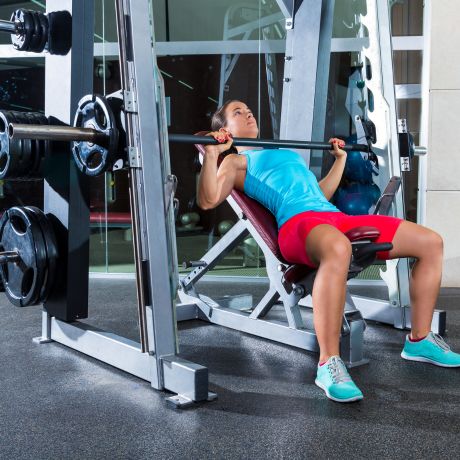
The Smith machine is on almost every list. However, it is usually in the worst category, which isn't right.
Dumping on the Smith machine is nothing new. Trainers have been doing it for years. I probably did, too, at some point. If so, I'm sorry because I was wrong.
The Smith machine is one of the best muscle-building machines at the gym. There, I said it. And the most significant benefit is actually what people use to discredit its ability to build muscle—stability.
It's no secret that the Smith machine is more stable than a barbell. In a sports or functional context, this is a disadvantage because you want to train all of the little stabilizing muscles. However, getting jacked is not as clear. Many people find that a Smith machine allows them to get a better mind-muscle connection on the target muscle. For example, not balancing the bar on a shoulder press allows them to focus more on pressing with their shoulders.
Keep in mind that I'm not comparing a barbell to a Smith machine. Data suggests that barbells are still king when it comes to muscle activation.¹ 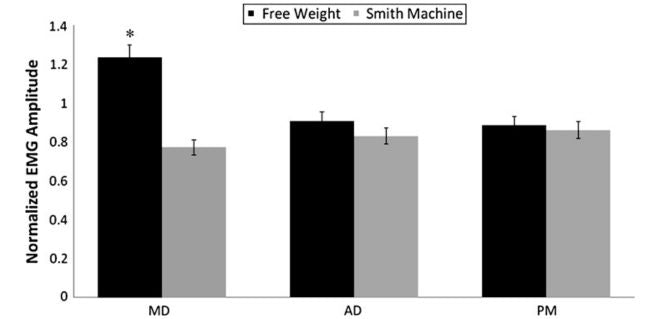
Figure 1: Schick, E. E., et al. (2010)
However, in terms of machines, the Smith machine is hard to beat as a solid variation. I mean, you can train your entire body on it.
My favorite Smith machine exercises include incline bench presses, seated shoulder presses, single-arm shrugs, rows, standing calf raises, hip thrusts, and Bulgarian split squats. Throwing one of these exercises into your routine will provide a nice variation to keep things interesting.
2: Cable Machine
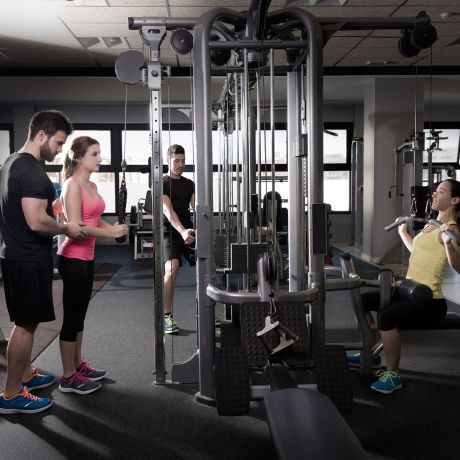
The cable machine has to be on the list. Like the Smith machine, it's one piece of equipment that can train the entire body. Moreover, the cable's design ensures that resistance remains consistent throughout the range of motion, creating a continuous tension that maximizes muscle engagement. Constant tension is arguably the most significant advantage of cable machines. In many free-weight movements, like the dumbbell lateral raise, gravity causes the strain to be higher at different points in the lift. That's not the case for cable lateral raises.
It could be a placebo effect or a product of the constant tension, but I always get nasty pumps on cable machines. I like to end most upper-body sessions with one or two cable exercises.
Cables are great for arm and shoulder work, but as I said, you can train your entire body with a cable machine. If you need help with ideas, here are the 18 best cable machine exercises.
3: Hack Squat
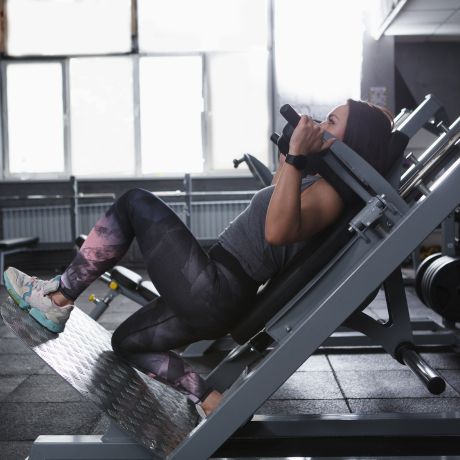
The hack squat might be one of the most underrated pieces of equipment in the gym. Yes, it's less versatile than the first two machines on the list, but it's excellent at what it does. The hack squat is one of the quintessential muscle-building leg machines in the gym. It allows you to load up substantial weight in a fixed motion, targeting the quads while engaging the glutes and hamstrings in a way that's typically safer and more controlled than free-weight squats. This safety feature is especially true for those with lower back issues.
My favorite aspect of a hack squat is it allows lifters to train close to failure without the balance concerns inherent in traditional squats. Since we know training close to failure is vital for muscle building, it's hard to argue the value of the hack squat.
4: Chest Supported Row
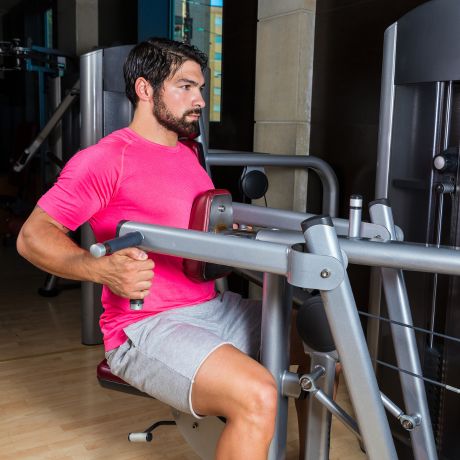
I may like the chest-supported row more than most. It's one of my favorite machines because it hits the upper back hard while minimizing strain on the lumbar region. After deadlifting, the last thing I want to do is barbell rows. That is a recipe for lower back pain.
Aside from safety, another benefit of the chest-supported row is that it's hard to cheat. Many back exercises, particularly rows, are commonly butchered. People cut their range of motion, use every muscle but their back, and then wonder why they can't build muscle. Sound familiar?
Stabilizing the chest against the pad allows for a full range of motion without sacrificing form. Keeping your chest against the pad makes using momentum to move the weight almost impossible. This targeted approach ensures that the upper back muscles, including the lats, traps, and rhomboids, are maximally engaged throughout each rep.
With the abundance of back machines in most gyms, this machine is easy to overlook. Don't make that mistake.
5: Pullover Machine
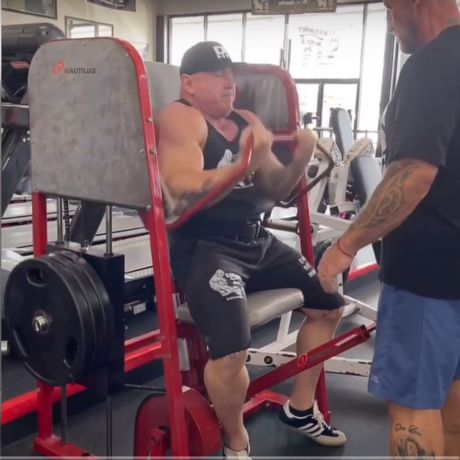
(Image courtesy of Morning Lifter YouTube)
You may have never used a pullover machine. It's a shame, but old-school pullovers are rare these days. I haven't seen one in a gym in years. However, if I walk into a gym with one, I must use it. Even if I'm training legs, I will throw in a couple of sets at the end. If you see one out in the wild, follow my lead and use it.
A favorite of six-time Mr. Olympia Dorian Yates, the pullover machine is a unique back exercise that isolates the lats while minimizing biceps involvement. Think about it: what is the weak link in most back exercises? It's the biceps. Often, your arms fatigue before your lats do.
We need to start a movement to bring back pullover machines. It's easily a top-five muscle-building machine, even though most gyms don't have one. Few back exercises train the lats in this range of motion. It's excellent for back and chest development, the serratus, and shoulder mobility.
The 5 Worst Machines at the Gym for Muscle Growth
Okay, now let's get to the fun part. Here are five machines you won't catch me dead on. I'm joking but also kind of serious.
1: Vertical Leg Press
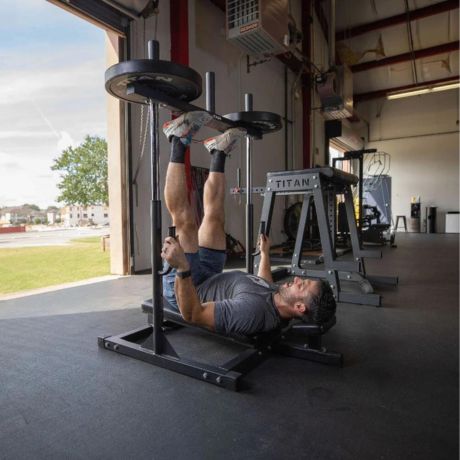
(Image credit to Titan Fitness)
The leg press. Oh boy, where do we begin? Do you want to know what's worse than a regular leg press? A vertical leg press.
Look, I have a love-hate relationship with these machines. I wouldn't say I like most leg presses, but a few are serviceable. The vertical leg press is not one of them. It's easily the worst.
While seemingly appealing for its uniqueness and ease of use, the vertical leg press machine lacks traditional leg press machines' biomechanical advantages and safety features. Its upright position places excessive strain on the lower back and spine, increasing the risk of injury, particularly for individuals with preexisting back issues. Additionally, the limited range of motion and lack of proper support diminish its effectiveness in targeting the lower body muscles, ultimately making it a suboptimal choice for leg strength and muscle building.
What to do instead: Back Squat, Front Squat, Hack squat, belt squat, goblet squat, Bulgarian split squat, lunges, or regular leg presses
2: Seated Ab Rotation
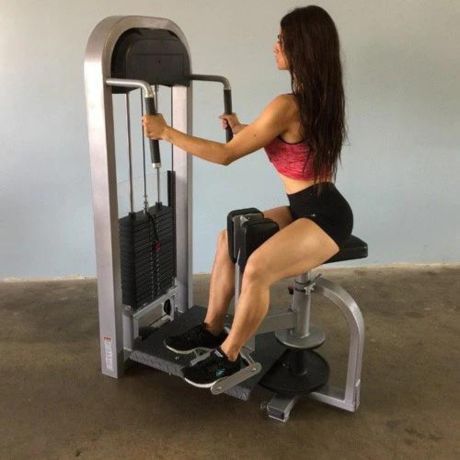
(Image credit to MuscleD Fit)
If you are unfamiliar with the seated ab rotation machine, it's the one where you sit down and twist side to side against resistance. It's not a terrible exercise, but it falls under what I consider a waste of space. There are too many better exercises that do the same thing.
If you want to train your obliques, pick one of the exercises below.
What to do instead: Band or Cable Palof Press, Bicycle Crunches, Medicine Ball Russian Twists, Weighted Side Bends, Side Plank, Suitcase Carries
3: Reverse Hyper
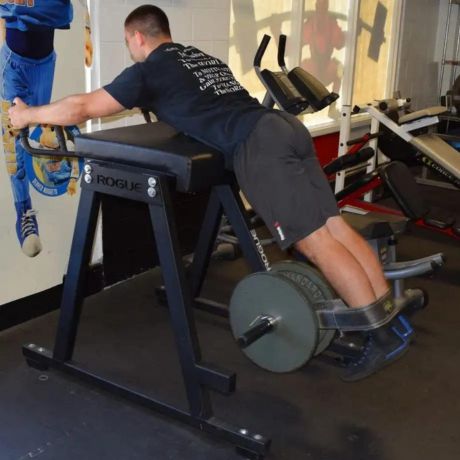
(Image credit to Mathias Method)
A reverse hyper is a specialized machine designed to target the posterior chain. It's unique because it allows the legs to move in a controlled arc behind the body while the torso is supported on a padded platform. Powerlifting legend Louie Simmons of Westside Barbell created it.
There was a time when saying anything bad about the reverse hyper would have kicked me out of the fitness industry. Luckily, I think that time has passed. RIP, Louie Simmons, but the reverse hyper is one of the most overrated machines in the gym. Joe Rogan played a part in this. Years ago, he used to sing the praises of the reverse hyper on his podcast, saying it cured his back pain.
While it may strengthen the lower back and glutes to some extent, it lacks the muscle activation capacity of other exercises like back extensions, leg curls, or hip thrusts, which are more effective for overall muscle development.
In a 2019 study comparing a back extension with a reverse hyper, muscle activity was significantly greater in back extensions for the glutes and hamstrings.²
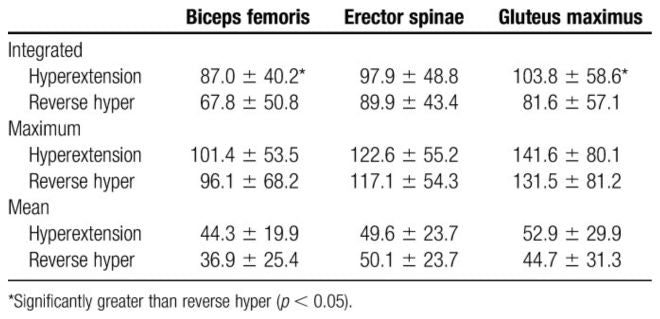
Figure 2: Lawrence, Michael A. (2019)
If your gym happens to have a reverse hyper, the good news is that it makes an excellent standing desk for your training notebook and shaker bottle.
What to do instead: Weighted Back Extensions, Glute Ham Raises, Leg Curls, Romanian Deadlifts, hip thrusts
4: Ab Coaster
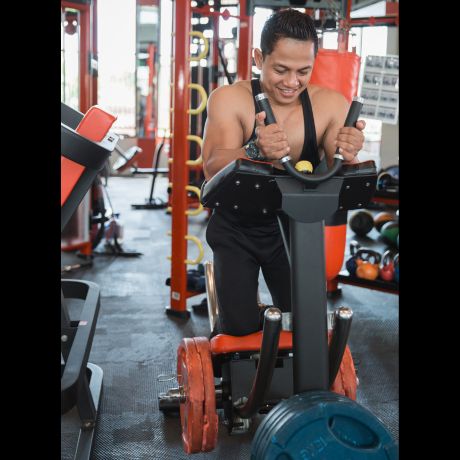
This one might make a few people mad. The ab coaster has a dedicated fan base. If you know how to use it correctly, it can be effective. The problem is that 90% of people do it wrong. Most people swing back and forth, letting momentum take over. Doing it this way is entirely ineffective for your abs. At this point, it is little more than an amusement park ride.
Using it correctly involves contracting your abs to raise yourself from the starting position, lowering yourself under control, and stopping. Don't let momentum keep you moving. For every repetition, begin at a dead stop. Even then, a cheap $10 ab wheel is better.
What to do instead: Ab Wheel, Plank, Weighted Sit Ups, Decline Sit Up, Cable Crunches, Hanging Leg Raises
5: 4-Way Neck Machine
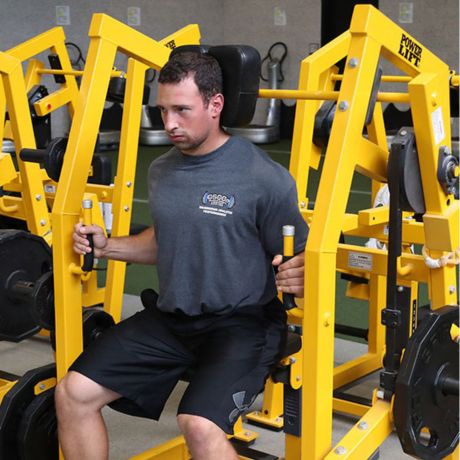
(Image credit to CSCCa)
I once trained at a gym with limited floor space, but they had a huge Hammer Strength 4-way neck machine. The machine literally took up as much space as a small squat rack. I trained at this place for three years and never saw anyone use the neck machine - not one person.
Look, this is not me bashing neck training. A thicker neck can be an impressive feature of your physique. And if you are involved in grappling sports, a strong neck is a must. That said, I can't think of a bigger waste of gym space than a neck machine.
A well-rounded neck program should include neck curls and weighted neck extensions with a harness. That's it. No machines are necessary.
What to do instead: Weight Plate Neck Curls, Weight Plate Neck Extensions, Neck Harness Extensions.
Bonus: Your Cell Phone
Okay, I know a cell phone is not a piece of gym equipment, but hear me out. We must prevent our phones from ruining our workouts.
I'm not old, but no one took their cell phone out on the gym floor when I started training. We kept it in the locker room. Before you applaud, leaving a Nokia Track phone in your locker doesn't take much self-discipline. As you can imagine, the smartphone has changed everything.
Scrolling wastes time and is distracting. The good news is that there is an easy fix to this problem. And, no, you don't need to leave your phone in the locker room.
I want you to start timing your workouts. In fact, you can use your phone to do this. As soon as you start training, begin the clock. When you finish the last set, hit stop and record the time. Just being mindful that you are timing the workout helps limit phone use.
It's not a race, but most workouts should only take 60-90 minutes. If you take considerably longer than this, you spend too much time on Instagram and TikTok. Please stop it. Your workouts will be more effective if you do.
What to do instead: During a workout, only use your phone for music and as a timer. Track your workouts the old-school way in a composition notebook. Trust me, that text can wait.
Pros and Cons of Machine Training
A 2023 study showed no differences between free weights and machines in terms of muscle-building potential.³ The researchers concluded that it comes down to personal preferences. That said, machine training does have advantages and disadvantages. Here are a few to keep in mind.
Pros
- Safety: I have a rule. If I'm going to get hurt in the weight room, it can't be on an assistance movement. Of course, you never want to get injured. But, if you are going for a new max on a squat, bench press, or deadlift, at least you got hurt going for something big. On the flip side, it's not worth it if you get banged up doing a skull crusher (how do you think it got that name?) or a barbell row. There are too many good machine exercises you could have done instead.
- Ease of Use: Machine exercises are easy to learn. Even a beginner can jump on a machine and do it right on the first or second try. As an intermediate or advanced lifter, since machines are easy to use, your form is less likely to break down when you get fatigued. This feature is valuable toward the end of a hard workout.
Cons
- Does Not Fit Your Body Properly: I'm a relatively short guy. For most things in the weight room, this is an advantage. However, some machines don't fit me well. I'm sure tall people have the same problem in the other direction. That said, if you spend time adjusting the machine, you can mitigate much of the problem.
- Limited Amount of Weight: If you are freakishly strong, you can run out of weight on some machine and cable exercises. It's not a problem many people face, but it's a problem we all should strive for.
Tips to Get the Most Out of Machine Training
Here are my three favorite ways to utilize machine training.
1. Train Close To Failure
As mentioned, machines are relatively safe. So, take advantage of their safety and train close to failure. For example, pushing a set of hack squats close to failure is much safer than doing that with back squats.
2. Use Drop Sets
With machine training, quickly changing weights is easy. Take advantage of it and incorporate drop sets. I like to reduce the weight by 50% and double the reps. So, if my set were 100 pounds for 10 reps, I would cut the weight to 50 pounds on the drop set and aim to do 20 reps.
3. Use Supersets
Similar to drop sets, machine training makes it easy to do supersets. The key is picking two machine exercises next to each other. One of my favorite supersets is a cable curl with a cable triceps press down. These two exercises are complementary, so while you are doing curls, your triceps get rest, and when you are doing press downs, your biceps get rest.
Wrap Up
Well, there you have it - the best and worst exercise machines for building muscle. Understanding the nuances of gym machinery is paramount in crafting an effective muscle-building program. While some, like the Smith and cable machine, stand out for their versatility and effectiveness, others, like the vertical leg press and seated ab rotation, fall short. If you prioritize the best machines and limit the worst, you will be well on your way to a better physique.
Are you looking to start a new workout program? We created the ultimate hypertrophy program to take your physique to the next level.
References:
- Schick, E. E., Coburn, J. W., Brown, L. E., Judelson, D. A., Khamoui, A. V., Tran, T. T., & Uribe, B. P. (2010). A comparison of muscle activation between a Smith machine and free weight bench press. Journal of strength and conditioning research, 24(3), 779–784.https://doi.org/10.1519/JSC.0b013e3181cc2237
- Lawrence, Michael A.1; Chin, Andrew2; Swanson, Brian T.3. Biomechanical Comparison of the Reverse Hyperextension Machine and the Hyperextension Exercise. Journal of Strength and Conditioning Research 33(8):p 2053-2056, August 2019. | DOI: 10.1519/JSC.0000000000003146
- Haugen, M.E., Vårvik, F.T., Larsen, S. et al. Effect of free-weight vs. machine-based strength training on maximal strength, hypertrophy and jump performance – a systematic review and meta-analysis. BMC Sports Sci Med Rehabil 15, 103 (2023). https://doi.org/10.1186/s13102-023-00713-4

Also in Blog
Recent Articles
-
Calories In, Calories Out Myth: Fact or Fiction?April 08, 2025
-
Cardio Or Strength Training: What's Better For Weight Loss?April 03, 2025
Must Reads
-
Mr Olympia 2024: What to Expect This Year (Oct. 10-13, 2024)September 11, 2024
-
What Can Walking For 1 Hour Everyday Do For You? My ExperienceFebruary 28, 2024
-
The Ultimate "Bro Split" Workout Plan (Backed By Science)August 05, 2023
- Blog
- Exercises
- Workouts
- Meal Plans
- SFS Programs
- Apparel
- About Us
- FAQ
- Shipping
- Warranty
- Contact Us
- Terms & Conditions
- Privacy Policy
- Affiliates
- SFS UGC Policy
- SFS MBG Policy
- Disclosures
- Legal Disclaimer
Sign up to get the latest on sales, new releases and more…
© 2025
SET FOR SET.
Powered by Shopify
















Kyle Hunt
Author